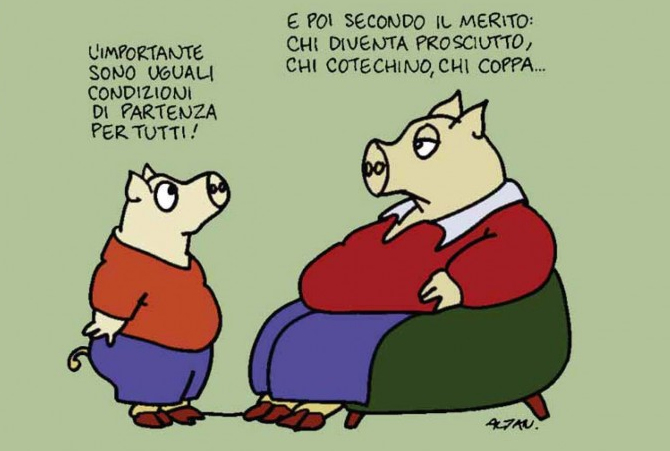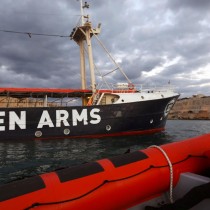La Torino-Lione è coerente con la strategia climatica dell’Unione Europea?
La Commissione Europea ha indicato per tutta l’Unione Europea l’obiettivo di ridurre le emissioni di gas serra nell’atmosfera di almeno il 55% entro il 2030, rispetto al livello del 1990.
Inoltre, la CE ha ribadito l’intenzione di raggiungere l’obiettivo della neutralità climatica entro il 2050.
Rivolgendosi al Consiglio europeo e al Parlamento europeo sul Green Deal europeo, la Commissione ha sottolineato la necessità di valutare sistematicamente la coerenza tra la legislazione attuale e le nuove priorità. Al fine di garantire che tutte le iniziative del Green Deal raggiungano i loro obiettivi, la Commissione prescrive che tutte le proposte legislative e gli atti delegati includano un memorandum contenente una sezione specifica che spieghi come ogni iniziativa sia conforme al principio “non nuocere”.
Considerando progetti come lo scavo di un tunnel internazionale tra Italia e Francia a servizio della nuova ferrovia Torino-Lione, è accertato che la fase di costruzione comporterebbe un aumento netto delle emissioni di gas serra: gli stessi proponenti stimano un’emissione complessiva di 10 milioni di tonnellate, anche se la loro valutazione non è certificata da alcuna autorità indipendente.
La Corte dei conti europea, nel suo Rapporto Speciale n. 10/2020, osserva che il progetto Torino-Lione è costantemente in ritardo rispetto al calendario ufficiale e che il suo completamento non può avvenire entro il 2030. Ciò significa che l’aumento netto della fase di emissione non terminerà probabilmente prima degli anni ’40 del secolo.
Le emissioni e i relativi danni climatici sono certi, mentre il sequestro del carbonio è altamente incerto e sicuramente tardivo, dato che dobbiamo raggiungere l’obiettivo delle zero emissioni nette. Come quando il “Il medico arriva al letto del paziente dopo la sua morte”.
Nello stesso rapporto, la Corte dei conti europea osserva anche che c’è un forte rischio che gli effetti positivi (in termini di riduzione dell’impatto) di molti progetti come quello della Torino-Lione siano sopravvalutati. In generale, tali effetti dipendono dai livelli di traffico e dal trasferimento modale ed entrambi tendono ad essere sistematicamente sopravvalutati. In pratica, per la Torino- Lione, una compensazione delle emissioni iniziali in eccesso potrebbe difficilmente avvenire prima del 2050 o anche molto più tardi, se le previsioni di traffico e di trasferimento modale non sono confermate.
Alla luce di quanto sopra, il sostegno dato dall’UE alla Torino-Lione (e a progetti simili) è coerente e compatibile con gli obiettivi ambientali fissati dall’UE?
In che modo?
Gli investimenti ad alta intensità di capitale producono più posti di lavoro degli investimenti finalizzati al perseguimento dell’obiettivo della neutralità climatica e della resilienza diffusa?
Le Lyon-Turin est-il cohérent avec la stratégie climatique de l’UE ?
LETTRE OUVERTE de Luca Mercalli, Angelo Tartaglia, Ugo Bardi, Sergio Ulgiati, Gianni Silvestrini, Pietro Salizzoni AUX LEADERS DE L’UNION EUROPEENNE
La Commission européenne a indiqué pour l’ensemble de l’Union l’objectif de réduire les émissions de gaz à effet de serre dans l’atmosphère d’au moins 55% d’ici 2030, par rapport au niveau de 1990.
En outre, la CE a réaffirmé son intention d’atteindre l’objectif de la neutralité climatique d’ici 2050.
En s’adressant au Conseil européen et au Parlement sur le “Green Deal” européen, la Commission a souligné la nécessité d’évaluer systématiquement la cohérence entre la législation actuelle et les nouvelles priorités. Afin de garantir que toutes les initiatives du Green Deal atteignent leurs objectifs, la Commission prescrit que toutes les propositions législatives et tous les actes délégués comprennent un mémorandum contenant une section spécifique expliquant comment chaque initiative respecte le principe de “ne pas nuire”.
Dans le cas de projets tels que le creusement d’un tunnel international entre l’Italie et la France pour desservir la nouvelle ligne ferroviaire Lyon-Turin, il est établi que la phase de construction entraînerait une augmentation nette des émissions de gaz à effet de serre : les promoteurs eux-mêmes estiment l’émission globale à 10 millions de tonnes, bien que leur évaluation ne soit certifiée par aucune autorité indépendante.
Dans son Rapport spécial n° 10/2020, la Cour des comptes européenne fait remarquer que le projet Lyon-Turin est constamment retardé par rapport au calendrier officiel et que son achèvement ne peut avoir lieu dans le délai de 2030. Cela signifie que l’augmentation nette de la phase d’émissions ne devrait pas se terminer avant les années 40 du siècle.
Les émissions et les dommages climatiques connexes sont certains, tandis que la séquestration du carbone est très incertaine et certainement tardive, alors que nous devons nous approcher de zéro émission nette. Quelque chose comme : “Le médecin est arrivé après la mort du patient.”
Dans le même rapport, la Cour des comptes européenne fait également remarquer qu’il existe un fort risque que les effets positifs (en termes de réduction de l’impact) de nombreux projets comme le Lyon-Turin soient surestimés. En général, ces effets dépendent des niveaux de trafic et du transfert modal et tendent tous deux à être systématiquement surestimés. En pratique, pour le projet Lyon-Turin, une compensation des émissions excédentaires initiales pourrait difficilement avoir lieu avant 2050 ou même beaucoup plus tard, si les prévisions de trafic et de transfert modal ne sont pas confirmées.
Compte tenu de ce qui précède, le soutien apporté par l’UE à la liaison Lyon-Turin (et aux projets similaires) est-il cohérent et compatible avec les objectifs environnementaux fixés par l’UE ?
Comment ?
Les investissements à forte intensité de capital produisent-ils plus d’emplois que les investissements visant à poursuivre l’objectif de neutralité climatique et de résilience diffuse ?
Is High Speed Rail Lyon-Turin consistent with EU climate strategy?
OPEN LETTER from Luca Mercalli, Angelo Tartaglia, Ugo Bardi, Sergio Ulgiati, Gianni Silvestrini, Pietro Salizzoni TO EU LEADERS
The European Commission has indicated for the whole Union the goal of reducing the greenhouse gas emissions to the atmosphere by at least 55% within 2030, with respect to the level of 1990.
Furthermore, the European Commission has reaffirmed the intention to meet the objective of climate-neutrality within 2050.
While addressing the European Council and the Parliament on the European Green Deal, the Commission has stressed the need of systematically assessing coherence between current legislation and new priorities. In order to ensure that all Green Deal initiatives achieve their objectives the Commission prescribes that all legislative proposals and delegated acts include a memorandum containing a specific section explaining how each initiative complies with the ‘do no harm’ principle.
Considering projects like digging an international tunnel between Italy and France along a new Lyon-Turin rail, it is ascertained that the construction phase would involve a net increase of the greenhouse gases emissions: the proponents themselves estimate an overall emission of 10 million tons, though their evaluation is not certified by any independent authority.
ECA, in its Special report n. 10/2020, remarks that the Lyon-Turin project is delayed with respect to the official timetable and its completion cannot occur within the 2030 deadline. This means that the net increase in the emissions phase is not likely to end before the ‘40s of the century.
Emissions and related climate damages are certain, while carbon reduction is highly uncertain and surely late, when we need to approach zero net emissions. Something like: “The doctor came after the patient had died.”
In the same report, ECA remarks also that there is a strong risk that the positive effects (in terms of impact reduction) of many projects like the Lyon- Turin are overestimated. In general, those effects depend on the traffic levels and the modal shift and both tend to be systematically overestimated. In practice, for the Lyon-Turin, a compensation of the initial excess emissions could hardly happen before 2050 or even much later, if traffic and modal shift forecasts are not confirmed.
In light of the above, is the support given by EU to the Lyon-Turin (and similar projects) consistent and compatible with the environmental targets fixed by EU?
How?
Does capital-intensive investment produce more jobs than widespread investments aimed at pursuing the goal of climate neutrality and diffused resilience?
Firmatari – Signataires – Signatories
Luca Mercalli, President of the Società Meteorologica Italiana
Angelo Tartaglia, Politecnico di Torino
Ugo Bardi, Università di Firenze
Sergio Ulgiati, Università degli Studi di Napoli Parthenope
Gianni Silvestrini, President of the scientific committee, Kyoto Club
Pietro Salizzoni, Ecole Centrale, Lyon
Destinatari – Destinataires – Addressees
Mrs. Ursula von der Leyen, President of the European Commission
Mr. Charles Michel, President of the European Council
Mr. David Sassoli, President of the European Parliament
Mr. Frans Timmermans, Executive EC vice-president: European Green Deal
Mrs. Adina Vălean, EU Transport Commissioner
Mr. Virginius Sinkevičius, EU Commissioner for the Environment
Cc Presidents of the European Parliament groups
Cc Italian Ministry of Environment
Cc Italian Ministry of Infrastructures
Cc French Ministry of Ecological Transition, Transport and Infrastructures
18/12/2020 http://www.presidioeuropa.net










Lascia un Commento
Vuoi partecipare alla discussione?Sentitevi liberi di contribuire!